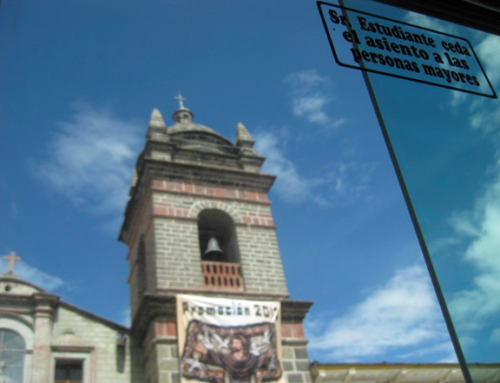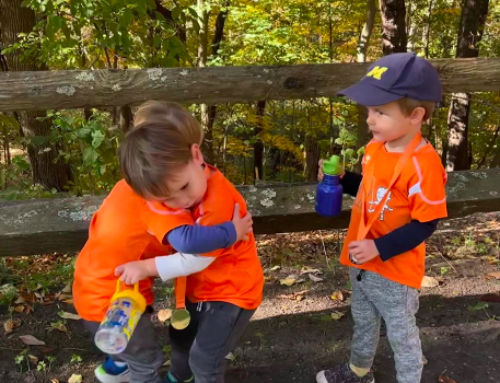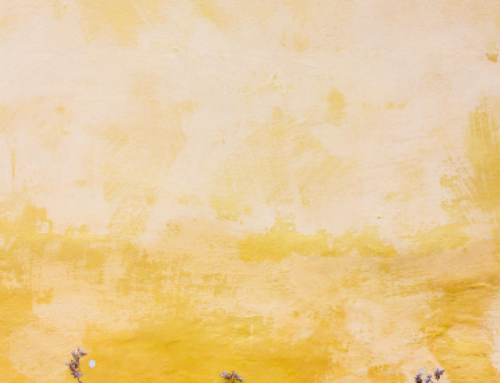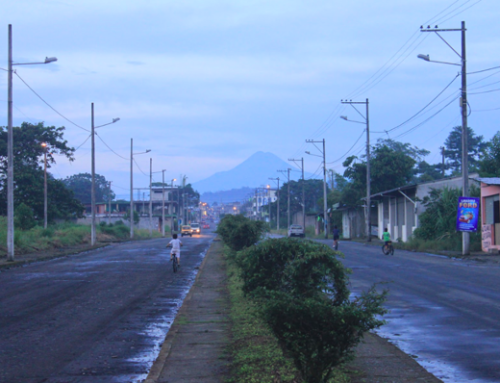I can hear Archie whining and moving restlessly, barking in a high-pitched voice at the wild wind that bites violently into the wooden panels of our house. He goes to the bathroom, where he jumps into the bathtub and curls up. Then he starts whining and barking again. At times, he goes up and down the stairs, moves to a different room for a few seconds, only to come back and freeze in the doorway: ears pricked back, eyes fixed, uncovering their whites. In the past, when the winds got strong—something very common on the northeastern coast of Scotland where we live—we tried all sorts of things: curling up with him on the floor while petting him; sleeping with him on the couch downstairs, where the sounds didn’t seem so loud; opening the door to the cupboard under the stairs, which we thought might offer him some refuge. Then we discovered some YouTube videos for “calming dogs.” For a while, the Zen-like music seemed to work, but next time the winds got stronger, Archie started his restless wander again. Finally, we seemed to have found a magical video of a shushing river mixed in with forest sounds on a calm day. This seemed to settle him through the whole night. He would curl on one side of the bed against the wall, release a deep sigh, and go to sleep. If the winds got stronger and Archie would become restless again, we would turn up the volume. The sound of the river would engulf the whole house and we would all fall asleep.
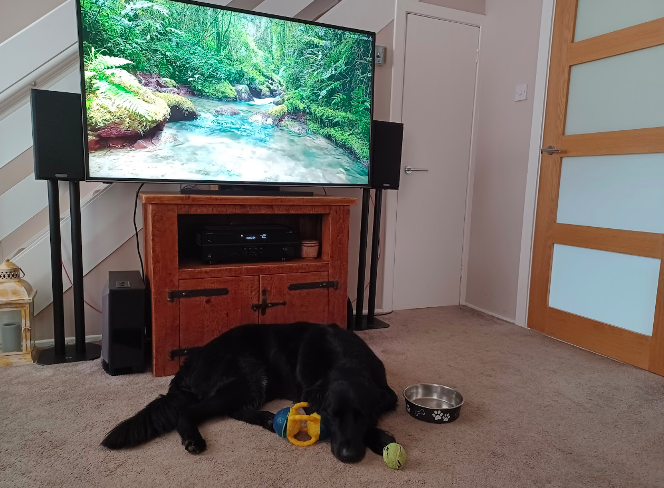
Caring for Archie, the (un)settled senior rescue dog. Photo credit: Cristina Douglas.
Archie is a nine-year-old dog who moved in with me and my husband about a year ago. We’ve been told he’s a Flat-Coated Retriever mixed with Alsatian and, probably, Collie. Theoretically, his mixed breeding should work in his favor when it comes to his physical health (Beuchat 2015). However, this may have worked against him socially. Mixed breed dogs are much more likely to be found in shelters than purebreds (Luescher and Medlock 2009). They are also more likely to be euthanized there, especially when older, since they are perceived as less appealing for adoption (Hawes, Kerrigan, and Morris 2018). We got Archie from one of the many rescue organizations that operate in the UK, after seeing a Facebook post desperate to find him a new home. Senior dogs like Archie, we’ve been told, don’t receive many applications for rehoming. Canine behaviorists say that it’s easier to “recondition” a younger dog than a senior, whose behavior has been ingrained for a long time. Moreover, people don’t seem to be willing to invest too much in a dog whose life expectancy might only be a few years. Rescuing dogs has its own economical hierarchy when it comes to life stages.
Archie is a dog with a troubled history. When he was taken in by the rescue organization, he was overweight and not very socialized with other dogs and people. He had been living in a small flat with no garden, and was somehow never walked outside. He was also displaying stereotypical coping behavior, chewing on logs or branches—some still attached to trees—while yelping loudly in distress. We worked with a canine behaviorist to help us deal with some of his issues. Once we developed and followed a routine with little or no variation, he settled and showed signs that he enjoyed his life much more. The same seemed to apply to his adjustment to the winds: once he’d experienced the strongest of these a few times, covered by the sound of the river, he managed to calm down. At least until a few months ago, when Aberdeenshire was struck by storm Otto. No matter how loud, the YouTube river didn’t mask the tumult outside, and Archie became hopelessly restless.
In an apparently settled world, Archie shows a great joy for life with his goofy, humorous personality. But to keep this joy is to attune my care beyond caring for this senior rescue dog. To keep this joy is to think of myself not only as a human living on a damaged planet, but also inescapably and morally caught in more-than-human matters of care, carrying both its good and its violence.
For the last year and a half, Scotland has been hit hard by a wave of storms that have cut power for days and decimated hundreds of hectares of pine forests. Pete Smith, Professor of Soils and Global Change at the University of Aberdeen, warns that these unexpected storms will become more recurrent as a consequence of climate change (Saunderson 2022). It’s somehow ironic that these extreme weather events are affectionately singled out with human names: Arwen, Malik, Corrie, Otto, Eunice, Franklin. Naming storms is a practice used by weather specialists to individualize their intensity and damage potential. Yet in naming them—a profound anthropomorphizing act—there is also, perhaps involuntarily, the implicit truth of human involvement in unsettling the atmosphere of our planet.
The era we live in is, in fact, also called by a name: the Anthropocene. Some suggest, though, that it should more accurately be called the “Capitalocene” for it is not humans that brought us to an era of planetary disruption, but rather a whole political and economic system that carries the ghosts of colonialism (Haraway 2015). The changes we now witness not only disrupt the living ways of wild species that are now considered extinct or endangered (van Dooren 2016), but they also unsettle the lives of other species, like dogs, that have been “successful” in living with us (Cimarelli et al. 2019, 1). In bringing them into our intimate space of kinship relations, we have also swept them along into the political and economic systems where our lives unfold in a damaging way. Care for other species, as for our own, can now only be carried out on a “damaged planet” (Tsing et al. 2017), marked by the global movement of humans and of the earth’s atmosphere. Indeed, it is in this era that human care becomes entangled with damage, transforming carescapes into Anthropocenic scapes. It is in this inescapable entanglement that caring for my dog is charged with “fallacies of care” (Lemos Dekker 2019)

Pine forest in Aberdeenshire after a storm. Photo credit: Cristina Douglas.
But what kind of care can we provide when that which carries the potential of repair for some contributes to damage elsewhere? When care becomes entangled with its violent doing (van Dooren 2015)? Our house is scattered with plastic toys designed to “enrich,” a term used by canine trainers and pet industries that morally frames our duty to care beyond a dog’s basic needs. With every new toy we get for Archie, he certainly seems filled with so much joy, playing with it for days until the novelty wears off. And, I must confess (not redeemable, either) that it feels so good seeing this old, unsettled dog experiencing so much joy in the moment. It feels like my care really matters, restores, and makes a bond possible where damage once seemed beyond repair. It is through these practices of care that Archie grows to trust humans and his surroundings despite his long-ingrained neglect, to accept the world as a livable place. And, in so doing, he helps me to think of the world in the same terms: if such a troubled dog can rekindle his joy and his trust, so can I.
Through relations of care, we become entangled with each other, and this has the power of transforming us. It may be this potential of transformation, as individuals and as society, that makes care such a powerful social and moral act.1 Yet from what I know, caring for Archie is neither innocent nor morally salvageable through the “rescuing the old, unadoptable mixed breed dog” rhetoric. My care is laden with invisible yet far-reaching violence to the earth. Archie’s diet is carefully balanced with wet and dry food, made by the same food industry that already contributes toward climate change (Pedrinelli et al. 2022). In tending to Archie’s care, then, I contribute to making this earth unlivable for other creatures—and, in the bigger picture, for our dog, too. Animals, dogs included, are more sensorially attuned to “weather worlds” (Ingold 2007). Dogs perceive changes in the earth’s atmosphere differently than we do, which might shift even more rapidly and radically during the Anthropocene (Lorimer, Hodgetts, and Barua 2019). By being attuned to the atmosphere of the earth, manifested to us in the unusually strong winds, Archie brings into our very own home the lack of care we’ve shown, and keep showing, to the earth. In this way, he becomes a “monster” of the Anthropocene (Tsing et al. 2017), symbiotically entangled with the unsettled atmosphere of our planet. But this also makes him a sentinel (Lorimer, Hodgetts, and Barua 2019), pointing “toward the monstrosities of modern Man” (Tsing et al. 2017, M2), toward the growing danger we’ve created for life on earth. Caring for this senior dog makes the damage palpable, unavoidable to witness and experience.
For Archie, the ghosts of the Anthropocene (Gan et al. 2017)— the exploitation of all sorts of earthly beings and resources for the comfortable lifestyle we’ve made for ourselves, those living in the “West,” and for those species living in our companionship—are violently disrupting his world. My care might not repair this world, as Archie’s care requires tending to more than his restless self, symbiotically linked to the earth. But in his very unsettledness, Archie becomes a force of nature forcing me to think of myself, too, as symbiotically entangled in the planetary assemblage of care and damage. It might be through this entanglement that I, as a human caring for an old rescue dog, become as well a monster of the Anthropocene: living through “[p]ulses of harm and care” and through “conflicting ways of being human” (Bird-Rose 2017, G58). It is through caring for this old rescue dog, though, that he can also rediscover a “great and joyful desire for life” (ibid.)— and me alongside him.
Notes
[1] As I learned through my PhD research into human-animal relations at the end of life with dementia, therapy-dogs have the potential to make life worth living in a system of fragmented (some might go even further by calling it “damaged”) system of care. It’s true that only highly settled dogs become therapy-dogs and that, at times, dogs can add to an existing emotional strain. At the same time, dogs can also make us happy (Jacobs Bao and Schreer 2016). Caring for a dog gives one a sense of purpose (Hawkins, Hawkins, and Tip 2021) and allows those caught in a system of receiving care to reverse their role in a healing way (Douglas 2021).
References
https://www.instituteofcaninebiology.org/blog/health-of-purebred-vs-mixed-breed-dogs-the-data.
Bird-Rose, Deborah. 2017.“Shimmer: When all you love is being trashed”, in Anna Tsing, Heather Swanson, Elaine Gan, Nils Bubandt, Arts of living on a damaged planet: Ghosts of the Anthropocene. Minneapolis: University of Minnesota Press.
Cimarelli, G., S. Marshall-Pescini, F. Range, Z. and Virányi. 2019. “Pet dogs’ relationships vary rather individually than according to partner’s species,” Scientific Reports B, no. 3437.
Douglas, Cristina. 2021.“A world of touch in a no-touch pandemic: Living with dementia in a care facility during COVID-19 pandemic.” Anthropology in Action 28, (1): 8-15.
Elaine Gan, Anna Tsing, Heather Swanson, Nils and Bubandt. 2017. “Introduction: Haunted landscapes of the Anthropocene”, in Arts of living on a damaged planet: Ghosts of the Anthropocene, ed. Anna Tsing, Heather Swanson, Elaine Gan, and Nils Bubandt.Minneapolis: University of Minnesota Press.
Haraway, Donna. 2015.“Anthropocene, Capitalocene, Plantationocene, Chthulucene: Making Kin.” Environmental Humanities 6 (1): 159–165.
Hawes, Sloane, Josephine Kerrigan, and Kevin Morris. 2018. “Factors Informing Outcomes for Older Cats and Dogs in Animal Shelters.” Animals (Basel) 8,(36): 1-13.
Hawkins, Roxanne D., Emma L. Hawkins & Liesbeth Tip. 2021.“’I can’t give up when I have them to care for’: people’s experiences of pets and their mental health.” Anthrozoös 3(44): 543-562.
Ingold, Tim. 2007.“Earth, sky, wind, and weather.” Journal of the Royal Anthropological Institute 13: S19–S38.
Jacobs Bao, Katherine and George Schreer. 2016.“Pets and happiness: Examining the association between pet ownership and wellbeing.” Anthrozoös 29 (2): 283-296.
Lemos Dekker, Natashe. 2019. “Competing good and fallacies of care: Moral deliberations at the end of life in the nursing home”. Journal of Aging Studies 51(100798):1-5
Lorimer, Jamie, Timothy Hodgetts, and Maan Barua. 2019.“Animals’ atmosphere.” Progress in Human Geography 43 (1): 26-45.
Luescher, Andrew Urs, and Robert Tyson Medlock. 2009. “The effects of training and environmental alterations on adoption success of shelter dogs.” Applied Animal Behaviour Science 117 (1-2): 63-68.
Pedrinelli, Vivian, Fabio A. Teixeira, Mariana R. Queiroz, and Marcio A. Brunetto. 2022.“Environmental impact of diets for dogs and cats.” Scientific Reports 12 (18510): 1-12.
Saunderson, Jamie. 2022“Aberdeen climate expert warns north-east likely to see more devastating storms.” Aberdeen Live(9 March 2022).
Swanson, Heather, Anna Tsing, Nils Bubandt, and Elaine Gan. 2017. “Introduction: Bodies tumbled into bodies”, in Arts of living on a damaged planet: Monsters of the Anthropocene, ed. Anna Tsing, Heather Swanson, Elaine Gan, and Nils Bubandt. Minneapolis: University of Minnesota Press.
Tsing, Anna, Heather Swanson, Elaine Gan, and Nils Bubandt, eds. 2017. Arts of living on a damaged planet: Ghosts and Monsters of the Anthropocene. Minneapolis: University of Minnesota Press.
van Dooren, Thom. 2015. “A Day with crows: Rarity, nativity and the violent-care of conservation.” Animal Studies Journal 4 (2): 1-28.
van Dooren, Thom. 2016. Flight ways: Life and loss at the edge of extinction. New York: Columbia University Press.
Cristina Douglas is a medical anthropologist, currently in the last stages of finishing her PhD at the University of Aberdeen, Scotland. Her PhD research explores how people living with advanced dementia in care homes develop relationships with the therapy-dogs who visit them. Cristina’s interest lies mostly around how later life unfolds in different settings, and how old age becomes entangled in more-than-human webs, both for humans and other-than-humans. In addition, Cristina is interested in research ethics, in particular in relation to ethnographic research conducted with prospective participants who may lack capacity to consent. Cristina is the recipient of the 1st place in the Doctoral Researcher Award UK competition in the Management and Social Sciences section (2021). Cristina’s research has been funded by University of Aberdeen through the Elphinstone Scholarship.
